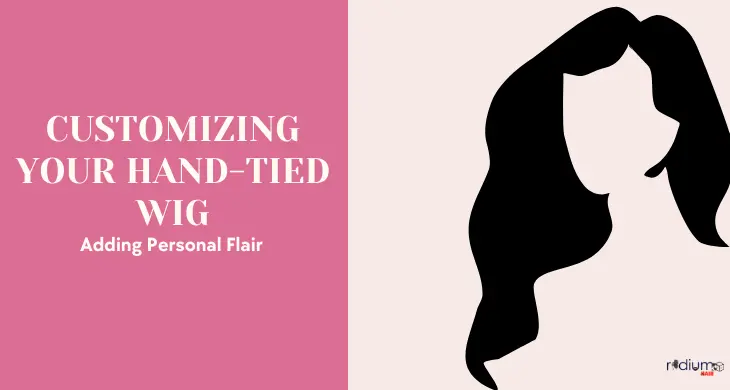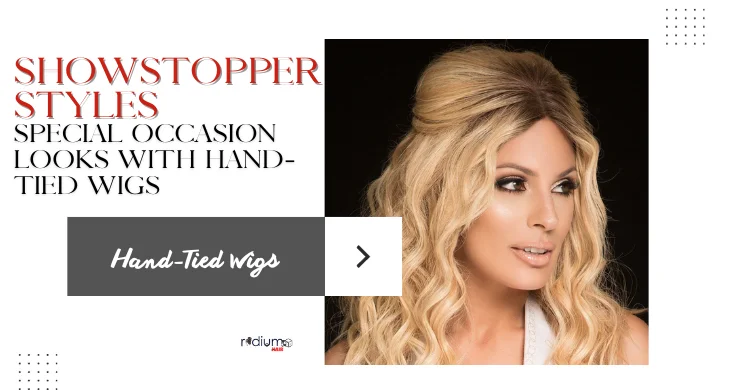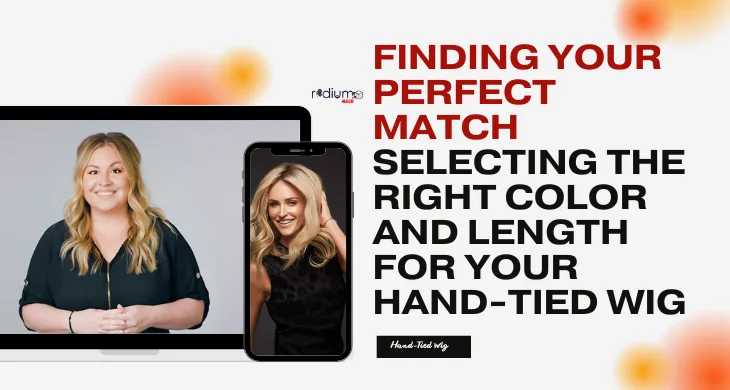No longer just a solution for hair loss, wigs have become a canvas for creativity and personal expression. Among the many types of wigs available, hand-tied wigs stand out for their superior comfort and realism. These wigs, meticulously crafted strand by strand, are the perfect choice for those who seek both luxury and versatility.
However, what truly sets hand-tied wigs apart is their potential for personalization. Whether you’re looking to enhance your daily style, prepare for a special event, or simply experiment with a new look, customizing your hand-tied wig allows you to add a unique flair that sets you apart from the rest.
We’ll delve into the art of wig personalization. From choosing the right base to selecting the perfect color, highlights, and style, we’ll explore every facet of making your hand-tied wig your own. You’ll discover that personalization isn’t just about aesthetics; it’s about embracing your identity and expressing yourself with confidence.
The Art of Wig Customization:
Wig customization is the intricate art of tailoring a wig to suit your unique style, preferences, and needs. It involves a combination of techniques and personal touches to transform a standard wig into a fashion statement or a natural-looking hair replacement solution.
The process of customization begins with selecting the right wig base, whether it’s a synthetic or human hair wig, full lace or hand-tied. Once you have the base, the real creativity takes shape. Here are some aspects that make up the art of wig customization:
- Color Customization: Changing the color of the wig is one of the most common customization methods. Whether you want a wig to match your natural hair color or experiment with bold shades, a professional colorist can expertly apply dye or color to achieve the desired look.
- Cut and Style: A well-chosen cut and style can transform your wig’s appearance. Layers, bangs, curls, and straight styles can all be tailored to your liking. A skilled hair stylist will ensure the wig flatters your face shape and reflects your personality.
- Texture and Curl Pattern: Matching the texture and curl pattern to your natural hair is crucial for a realistic look. A skilled stylist can replicate a wide range of textures, from sleek and straight to coily and curly.
- Density Adjustment: Adjusting the hair density ensures that the wig doesn’t look too thin or overly voluminous. This process helps create a natural and balanced appearance.
- Hairline Customization: Creating a natural hairline is one of the most critical aspects of wig customization. A stylist can add baby hairs, customize the part, or even create a widow’s peak to mimic the appearance of real hair.
- Accessories and Embellishments: Customizing a wig doesn’t stop at the hair itself. You can add headbands, clips, bows, or even sew-in accessories to enhance the wig’s aesthetics and your overall style.
Choosing the Right Wig Base:
The foundation of any wig customization journey is selecting the right wig base. The wig base is essentially the canvas on which you’ll work your customization magic. The choice of base profoundly influences the final look, feel, and versatility of your customized wig. Here are the key factors to consider when choosing the right wig base:
1. Hair Type:
- Human Hair Wigs: These wigs offer the most natural look and feel. They are highly customizable, allowing you to dye, style, and treat them like your own hair. Human hair wigs come in various types, such as European, Indian, or Brazilian hair, each with unique qualities.
- Synthetic Hair Wigs: Synthetic wigs are pre-styled and retain their shape, making them low-maintenance. They are an excellent choice if you want a specific look without much effort. However, they are less versatile when it comes to restyling.
2. Wig Construction:
- Lace Front Wigs: These wigs have a lace frontal section that creates a natural-looking hairline. They offer styling flexibility, allowing you to part the hair in different directions.
- Full Lace Wigs: These wigs have a lace cap that covers the entire head, providing more versatility in parting and styling.
- Hand-Tied Wigs: Hand-tied wigs are known for their comfort and natural appearance. The hair is meticulously hand-knotted into the cap, mimicking the way hair grows from the scalp.
3. Cap Type:
- Monofilament Caps: These caps feature a fine, breathable material that mimics the appearance of a natural scalp. They are ideal for a realistic look and can be part of lace front or full lace wigs.
- Wefted Caps: Wefted caps are durable and cost-effective. They consist of rows of hair wefts sewn together, offering good coverage and airflow.
4. Hair Length:
- The length of the wig’s hair is a matter of personal preference. Consider the style you want to achieve and whether you want short, medium, or long hair.
5. Hair Texture:
- Hair texture refers to the wave or curl pattern of the hair. You can find wigs with straight, wavy, curly, or kinky textures. Choose a texture that matches your natural hair or the style you desire.
6. Hair Color:
- Whether you want to match your natural hair color or experiment with a new hue, the wig’s color should reflect your style and personality.
Wig Color and Highlights:
Choosing the perfect wig color and highlights is a crucial step in customizing your wig to match your unique style and personality. Here’s a closer look at how to select the ideal wig color and highlights:
1. Consider Your Natural Hair Color:
- If you want your wig to resemble your natural hair, it’s essential to choose a color that closely matches it. Look for wig shades that are within the same color family as your natural hair.
2. Skin Tone Match:
- Your skin tone plays a significant role in determining which wig colors will complement your overall look. Here are some general guidelines:
- Warm skin tones often pair well with colors like honey, caramel, and auburn.
- Cool skin tones tend to harmonize with ash, platinum, and shades with blue or violet undertones.
- Neutral skin tones have the flexibility to pull off a wide range of wig colors.
3. Base Color:
- Choose a primary base color that serves as the foundation of your wig. This color covers the majority of the wig’s hair.
4. Highlight Color:
- Highlights add dimension and depth to your wig, mimicking the way natural hair catches light. They can be a slightly lighter or darker shade than the base color. Common highlight colors include blonde, caramel, or even vibrant colors like red or blue for a striking look.
5. Balayage or Ombre Effects:
- Balayage and ombre are coloring techniques that blend the base color into lighter shades at the ends. Balayage offers a more subtle transition, while ombre provides a more distinct contrast.
6. Test Swatches:
- Many wig retailers offer color swatches or sample rings that you can use to compare wig colors with your skin tone and style. These swatches can be incredibly helpful in making the right choice.
Wig Hairstyling and Cutting:
Wig hairstyling and cutting are essential aspects of customizing your wig to achieve your desired look. Here’s a guide on how to style and cut your wig:
Wig Hairstyling:
- Wash and Condition: Before styling, make sure your wig is clean and conditioned. Use a wig-specific shampoo and conditioner to maintain the wig’s quality.
- Detangle: Gently comb or brush your wig to remove any tangles.
- Heat Styling: If your wig is heat-resistant, you can use styling tools like flat irons, curling irons, and hot rollers to create various hairstyles. Always test a small section of the wig to ensure it can withstand the heat.
- Wig Styling Products: Use wig-specific styling products like wig spray, gel, or mousse to set your desired style. These products are designed to hold the wig’s shape without damaging the fibers.
- Curling: To create curls or waves, wrap sections of hair around a curling iron or hot roller and hold for a few seconds. Release the hair gently.
- Straightening: For straight styles, use a flat iron to smooth out the hair sections. Keep the iron moving to avoid heat damage.
Wig Cutting:
- Use the Right Tools: Invest in a pair of sharp, professional hair-cutting scissors. Avoid using regular household scissors, as they can damage the wig’s fibers.
- Styling on a Mannequin Head: Place the wig on a mannequin head to stabilize it while cutting. Ensure the mannequin head is secured in place.
- Start Slowly: It’s best to cut a little at a time. You can always trim more if needed, but you can’t undo an overly short cut.
- Layering: To create layers, gather sections of hair and cut at different lengths. This adds dimension and volume to the wig.
- Face Framing: When cutting bangs or face-framing layers, always start longer than your intended length. You can adjust the length gradually.
- Texturizing: Texturizing shears can be used to soften the ends and create a more natural look. These scissors have teeth that remove bulk without creating blunt edges.
Maintenance and Care:
Proper maintenance and care are crucial to preserving the quality and longevity of your hand-tied wig. Here’s a comprehensive guide on how to maintain and care for your hand-tied wig:
Daily Care:
- Brushing: Gently brush your wig daily to prevent tangles and maintain its style. Use a wig brush or a wide-tooth comb. Start at the tips and work your way up, holding the hair at the base to prevent undue tension on the wig cap.
- Wearing: Avoid wearing your wig in environments with extreme heat, like ovens or open flames, as it can damage the fibers.
Washing:
- Frequency: How often you should wash your wig depends on how frequently you wear it. If you wear it daily, wash it every 7-10 days. For occasional wear, wash it after 10-15 wears.
- Detangling: Before washing, gently detangle your wig to remove any knots.
- Fill a Basin: Fill a basin with cold water and add a small amount of wig-specific shampoo.
- Soaking: Submerge the wig in the soapy water, gently swirling it around.
- Rinsing: Rinse the wig thoroughly with cold water until all the shampoo is removed.
Styling:
- Heat Styling: If your wig is heat-resistant, you can use low to medium heat settings on styling tools. Remember to use a heat protectant spray to prevent damage.
- Styling Products: Use wig-specific styling products like wig spray, gel, or mousse to hold the style without damaging the fibers.
Wig Personalization Ideas:
Personalizing your hand-tied wig can add a unique and stylish touch to your look. Here are some wig personalization ideas to consider:
- Add Hair Accessories: Complement your wig with hair accessories like headbands, hairpins, and decorative hair clips.
- Scarves and Head Wraps: Experiment with scarves, turbans, and head wraps to create different looks that match your style and outfit.
- Changing the Part: If your wig allows for it, change the parting of your wig to create a fresh and different appearance.
- Heat-Resistant Wigs: If you have a heat-resistant wig, you can experiment with various hairstyles using curling irons, straighteners, and other heat styling tools.
- Hair Color Chalk: Temporary hair color chalk allows you to change the color of your wig temporarily. You can add fun highlights or experiment with vibrant colors without any permanent commitment.
- Accessories: Personalize your wig with accessories like hats, bandanas, or decorative hair pins. This can give your wig a whole new look and add a personal touch to your style.
- Hair Sprays and Serums: Use specialized wig care products like sprays and serums designed to maintain the wig’s quality and style.
- Cutting and Styling: For those with experience or access to a professional wig stylist, consider customizing the length and style of your wig for a unique look.
- Customized Hairline: If your hand-tied wig allows, work with a professional to customize the hairline to make it look even more natural and tailored to your preferences.
Frequently Asked Question:
1. Can I dye or color my hand-tied wig to match my natural hair color?
While it’s generally not recommended to dye or color synthetic wigs, hand-tied wigs can often be dyed or colored by a professional stylist. Keep in mind that this process should be approached with care to avoid damaging the wig.
2.How can I add highlights or lowlights to my wig for a more natural look?
Highlights and lowlights can be added to human hair hand-tied wigs to achieve a more natural appearance. A professional stylist can expertly blend and color the wig to match your desired look.
3.Are there any limitations to customizing hand-tied wigs?
The extent of customization for hand-tied wigs depends on whether the wig is made from synthetic or human hair. Human hair wigs offer more versatility for customization, while synthetic wigs have limitations.
4.Can I style my hand-tied wig differently every day?
Yes, you can style your hand-tied wig in various ways to create different looks. However, remember to use styling products and tools designed for wigs to ensure longevity and maintain the wig’s quality.
5.How do I find a professional stylist experienced in customizing wigs?
Look for stylists who specialize in wig customization or wig services. They should have experience working with both synthetic and human hair wigs to ensure your wig receives expert care.
Conclusion:
It’s essential to recognize that customizing your hand-tied wig is about more than just appearances. It’s a means to boost your self-esteem and empower yourself in a world where confidence is key. Whether you’re facing the challenges of hair loss, experimenting with a new look, or simply seeking a change, your hand-tied wig becomes a reflection of your unique identity.
With the knowledge and inspiration gained from this guide, you’re equipped to make your hand-tied wig an extension of your personality. Whether you choose vibrant colors, stylish cuts, or subtle highlights, each decision is a brushstroke on your canvas of self-expression.
So go forth, embrace your style, and flaunt your individuality. Your hand-tied wig is not just a fashion accessory; it’s a symbol of your confidence and your ability to stand out in a world where being yourself is the most beautiful thing you can be. Remember, the most beautiful thing about you is that you’re you.



